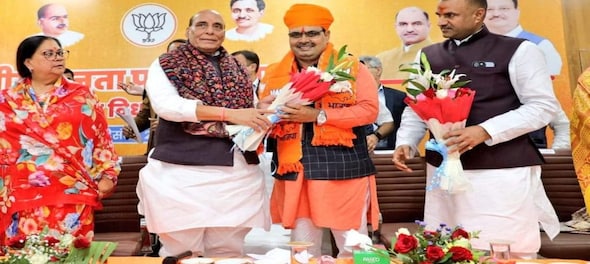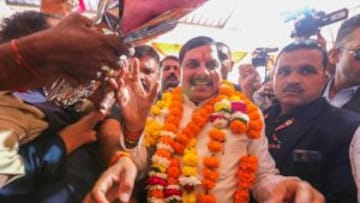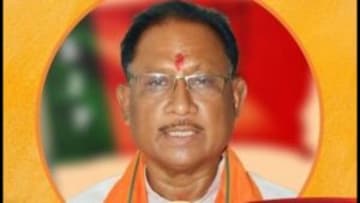
In the end the script ran along predictable lines. In fact, signs of the predictability of Bharatiya Janata Party's central leadership to promote members with little or no public profile to lead a state government came in the run up to the Assembly polls. Post-results, the obviousness of the move was confirmed in Chhattisgarh, followed in Madhya Pradesh and completed in Rajasthan.
Both in Madhya Pradesh and Rajasthan, there were enough indications that neither Shivraj Singh Chauhan nor Vasundhara Raje could assume to be in the saddle of the Chief Minister once again. The decision of installing Vishnu Deo Sai in Chhattisgarh, suggested that political observers can be certain of witnessing a new person at the helm of governments in MP and Rajasthan.
The effort of the party’s willingness to go forward with new or less experienced legislators came in the backdrop of a strong pressure mounted from within its ranks to entrust the task to leaders firmly entrenched in the state. Handing over reins of a new government to untested administrators demonstrated both the confidence and adroitness of the central leadership in this political experiment.
In one stroke it carried several messages. The foremost of it was effecting a generational change; striking a balance of power among various influential communities who backed the BJP; promoted trusted, hardworking, and, low profile party members with strong ideological moorings. All these came six months short of the Lok Sabha polls.
A peep into the past
Over the past nine years, since the march of the party under Prime Minister Narendra Modi with Home Minister Amit Shah, including his earlier role as the party president, the BJP leadership did not flinch from embarking on a new path. The first sign came when Manohar Lal Khattar was made the Chief Minister in Haryana in 2014.
Even though Khattar faced challenges, administrative and political, the central leadership stood firmly behind and the BJP retained the right to govern once again in 2019, though it needed support from an ally. A similar bulwark would be available for the new incumbents as they settle down in these three states to govern.
Looking ahead
The BJP retains strong presence and influence in these three Hindi heartland States, with MP being one of the front-runners of its campaign. For the past two decades, barring a short duration, the party formed the government. Since the Bhojshala issue or the Vanvasi programme in tribal districts of Jhabua, bordering Gujarat, the BJP-RSS remained active in these parts.
 Madhya Pradesh's new chief minister Mohan Yadav (PTI)
Madhya Pradesh's new chief minister Mohan Yadav (PTI)In electing Mohan Yadav instead of Chauhan in MP and Bhajan Lal Sharma in Rajasthan ahead of Raje, the leadership at the central level took time to underscore that it thought it through. In the process, the party’s decision prevailed over established state leaders’ proclivity to ruffle the feathers. The fact that the existing line of leadership endorsed the newcomers also sent a message to workers loyal to these regional satraps.
The election of leaders in each of these states is aimed to address the current dynamics and anticipate expected change of political landscape in the home stretch to the Lok Sabha Polls.
Calculation of having a Yadav as CM in Madhya Pradesh who belongs to Other Backward Communities is aimed at taking care of the impending demand of a nation-wide caste census the opposition is pushing for. It also extended the arc of influence of the Yadavs, who backed the Samajwadi Party in neighbouring Uttar Pradesh or the Rashtriya Janata Dal in Bihar.
 Vishnu Deo Sai was sworn-in as the new Chief Minister of Chhattisgarh on Wednesday.
Vishnu Deo Sai was sworn-in as the new Chief Minister of Chhattisgarh on Wednesday.In Chhattisgarh, former Union Minister Vishnu Deo Sai is a tribal and the state has a substantial portion of voters from the tribal belt. The OBCs are another influential section and to appeal to this section, the BJP brought in Arun Sao as the Deputy Chief Minister along with Vijay Sharma, from the Brahmin community, known to be strong supporters of the BJP. Similar experiments with social engineering have been done both in Rajasthan and MP.
This, in a way, is the BJP’s way to respond to the Opposition which promised to queer the electoral pitch by raising that people be counted by their caste. It is early to conclude that the recent setback for the Congress in state elections can be interpreted as a verdict against this demand.
By entrusting leadership to the party members who ordinarily do not figure in public discourse, outside of their respective sphere, the BJP leadership underscored the organisation recognises work and silent contribution as an asset.
Critics can indulge in surmising that the move to anoint not-so-well-known members as leaders comes with its own drawbacks. Yet, it provides the central leadership with an opportunity to harness the immense potential of the party and direct collective energies towards extending the tenure of PM Modi’s government when the time comes next summer.
—The author, K V Prasad, is a political analyst and writer. The views expressed are personal.
Read his previous articles here
(Edited by : C H Unnikrishnan)
First Published: Dec 14, 2023 9:43 AM IST
Check out our in-depth Market Coverage, Business News & get real-time Stock Market Updates on CNBC-TV18. Also, Watch our channels CNBC-TV18, CNBC Awaaz and CNBC Bajar Live on-the-go!


Supreme Court dismisses plea seeking postponement of CA exams; details here
Apr 29, 2024 2:29 PM
Just 8% women candidates contested first two phases of Lok Sabha polls
Apr 29, 2024 12:00 PM
The sexual assault case against Prajwal Revanna — here's what we know so far
Apr 29, 2024 11:36 AM
Repolling underway at one polling booth in Chamarajanagar LS segment in Karnataka
Apr 29, 2024 10:32 AM

